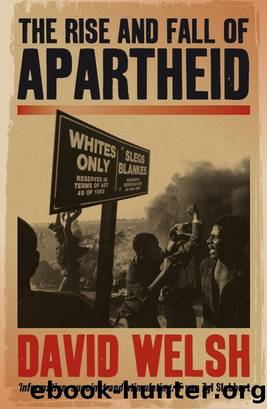The Rise And Fall Of Apartheid by Welsh David

Author:Welsh, David
Language: eng
Format: epub
Tags: History
ISBN: 9781868424108
Publisher: Jonathan Ball Publishers
Published: 2009-12-30T16:00:00+00:00
1965
1981
1965
1981
Clerical
83.10%
65.50%
9.10%
17.80%
Sales
72.70%
59.60%
15.20%
25.00%
Artisan
85.50%
73.10%
0.40%
5.90%
Foremen and supervisors
76.70%
56.90%
13.50%
26.50%
Another factor conducive to unionism was the changing scale of industrial and other enterprises: they were becoming larger, employing more workers, thus facilitating their mobilisation in trade unions.
By the late 1970s multinational corporations were beginning to feel the pressure of international criticism that would, by the early 1980s, become pressure to disinvest. It made sense to try to neutralise these pressures by accepting the unionisation of their workforces, as well as abolishing internal discriminatory practices. The Wiehahn Commission, noting these pressures and declaring stoutly that it would not be influenced by them, nevertheless concluded that it would be naïve to ignore them:
The presence of multinational subsidiaries of multinational enterprises within a countryâs borders creates a conduit through which strong influences and pressure can be exerted ⦠. The Commission is aware that, while the State can readily withstand and curb foreign pressures and influences, this is much more difficult for subsidiaries of multinational enterprises.127
Clearly it had been the stateâs intention to use registration of unions as a means of exerting control over their activities, in particular preventing them from using their muscle for political purposes.
Among the first issues to confront the emerging union movement was whether to register and participate in the industrial council system. The unions that opposed registration argued that it would lead to greater control by the state and, moreover, inveigle them into a bureaucratic system that would diminish worker control of their leaders. Other unions, however, disputed this: âThey saw the new laws as a site of struggle. These laws could provide some spaces where unions could win workersâ rights.â128 The debate was a divisive one; underlying it was the old question of whether to participate in or to boycott state-initiated structures.
Whether to participate in industrial councils raised the same issue. These councils were viewed with suspicion by the emergent unions as bureaucratic, racist institutions in which management, white unions and the state colluded at the expense of black workers. Moreover, the councils operated on an industry-wide basis, whereas the unions were plant-based, having decided that their priority was to build solid organisations within individual factories. The burgeoning growth of the unions in the early 1980s, fuelled by a wave of strikes, called for a new approach that could link workers in the same industry and create a more cohesive force. Led by the Metal and Allied Workers Union (Mawu), the new strategy involved participating in the council structure as a means of mobilising on a national basis while retaining a power-base at factory level.129 Ironically, the growing influence in the industrial council of the National Union of Metalworkers of South Africa, formed by a merger of Mawu and other unions, prompted some employers to seek to revert to plant-level bargaining. The decision to âopt inâ to an officially sponsored structure played a significant role in promoting union growth and cohesiveness. It also resolved the debate about registration.
By the early 1980s, another even larger issue had arisen: the relationship between unions and political organisations, which became more pressing as political tumult engulfed black communities.
Download
This site does not store any files on its server. We only index and link to content provided by other sites. Please contact the content providers to delete copyright contents if any and email us, we'll remove relevant links or contents immediately.
| Africa | Americas |
| Arctic & Antarctica | Asia |
| Australia & Oceania | Europe |
| Middle East | Russia |
| United States | World |
| Ancient Civilizations | Military |
| Historical Study & Educational Resources |
The Battle of Mogadishu by Matt Eversmann & Dan Schilling(723)
The Confidence Men by Margalit Fox(671)
A History of the Muslim World since 1260: The Making of a Global Community by Vernon O. Egger(641)
The Spymaster of Baghdad by Margaret Coker(641)
Jack the Ripper and the East End by Peter Ackroyd(609)
Empire of Fear: Inside the Islamic State by Andrew Hosken(586)
The Afghanistan File by Prince Turki AlFaisal Al Saud(586)
The Crimean War by Winfried Baumgart(578)
Islam At The Gates: How Christendom Defeated the Ottoman Turks by Diane Moczar(571)
The Jerusalem Diamond by Noah Gordon(567)
Akhenaten by Dominic Montserrat(565)
A Concise History of Greece (Cambridge Concise Histories) by Richard Clogg(554)
Beirut 2020 by Charif Majdalani(554)
The History of Jihad by Robert Spencer(547)
Israel: Ancient Kingdom or Late Invention? by Daniel I. Block(532)
Enemy in the East by Rolf-Dieter Müller(532)
The Privatization of Israeli Security by Shir Hever(524)
The Nine Lives of Pakistan by Declan WALSH(521)
Destroying a Nation: The Civil War in Syria by Nikolaos van Dam(515)
